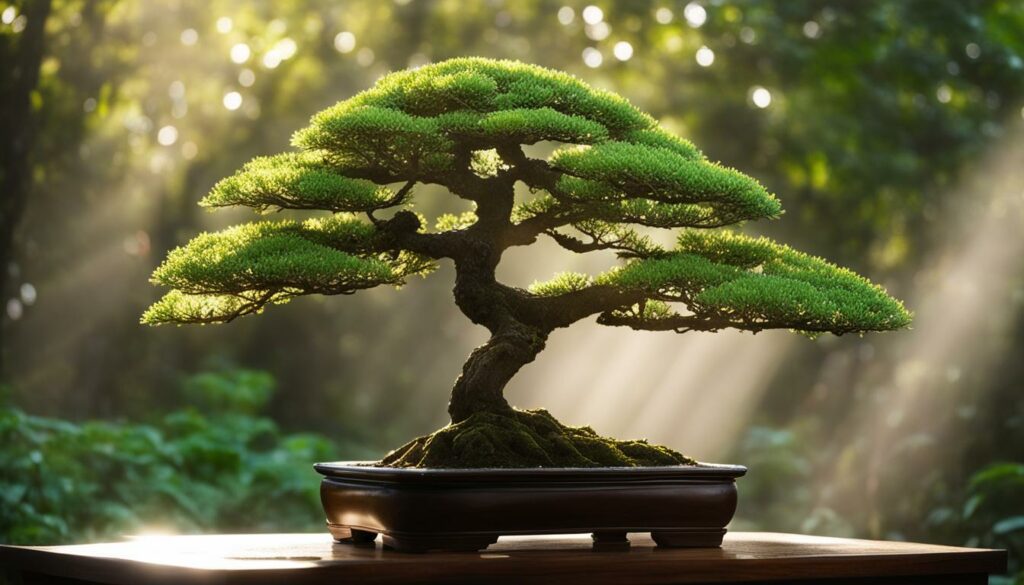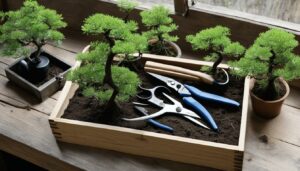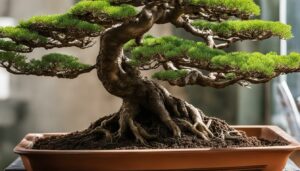Embarking on the journey of bonsai care, you’re not just cultivating a plant; you’re sculpting a living artwork. Key to this delicate process is creating an optimal bonsai environment that mimics the natural conditions these miniature trees thrive in. Understanding the significance of bonsai humidity and air circulation is crucial in fostering a habitat for your bonsai that encourages robust health and aesthetic grace. In this guide, we’ll dive into the essentials of managing these elements, ensuring that your commitment to bonsai care is rewarded with a flourishing miniature landscape.
Key Takeaways
- Identify the importance of proper humidity levels for maintaining bonsai health.
- Recognize the role of air circulation in preventing disease and encouraging growth.
- Discover strategies for monitoring and adjusting the bonsai environment.
- Learn how different bonsai species may require varied humidity and air quality conditions.
- Explore tools and techniques for creating and sustaining the ideal climate for your bonsai.
Understanding the Importance of Humidity for Bonsai Trees
When nurturing a bonsai, the right humidity levels play a pivotal role in ensuring your miniature tree’s health and vigor. Just as these plants have unique styles and forms, their moisture requirements can vary significantly, reflecting the diversity of their natural environments. Let’s take a closer look at why maintaining appropriate humidity is essential for bonsai care.
Humidity, the presence of water vapor in the air, directly affects a bonsai’s ability to transpire and photosynthesize efficiently. Low humidity levels can lead to moisture loss, causing leaves to dry out and weakening the plant’s overall health. On the other hand, excessive humidity can promote the growth of mold and bacteria, potentially leading to disease. By learning about your specific bonsai’s habitat and moisture needs, you can replicate the ideal humidity setting to foster a lush, robust life.
- Consider the species: Research if your bonsai is from a tropical, subtropical, or temperate climate, as each will have distinct humidity preferences.
- Seasonal adjustments: Recognize that your bonsai’s humidity needs may change with the seasons and adjust your care routine accordingly.
- Signs of distress: Watch for indicators such as brown leaf tips or wilted foliage, which may suggest that the current humidity level is not optimal.
Mastering the art of humidity control can seem daunting, but it is a critical skill in the bonsai hobbyist’s repertoire. With a thoughtful approach to your tree’s environment, you can avoid the common pitfalls of under or over-humidifying, ensuring that your bonsai thrives for years to come.
The Role of Air Quality in Bonsai Care
Ensuring the longevity and vitality of your bonsai tree hinges on the understanding of air quality and its impact on healthy bonsai growth. Fluctuating conditions in your home may introduce indoor air pollutants that can be detrimental to your bonsai’s well-being. Let’s explore the common issues affecting air quality and practical ways to boost the atmosphere your plant resides in.
Common Air Quality Issues
Many indoor environments harbor unseen contaminants that may negatively influence your bonsai’s health. From everyday household cleaners to tobacco smoke, sources of pollution are numerous and varied. These indoor air pollutants can disrupt the delicate balance required for your bonsai to thrive, leading to a suboptimal environment that constrains growth and vigor.
Indoor air quality can have a significant effect on the intricate balance of moisture, nutrients, and overall plant health essential for bonsai trees to flourish.
Improving Your Indoor Air for Bonsai Health
To combat the adverse effects of poor air quality, it’s essential to curate a space that promotes clean air circulation. Research has shown that certain houseplants can act as natural air purifiers, absorbing harmful toxins and emitting clean oxygen, which contributes to healthy bonsai growth. In addition, minimizing the use of aerosols and opting for eco-friendly cleaning products can make a substantial difference in improving the air quality around your bonsai.
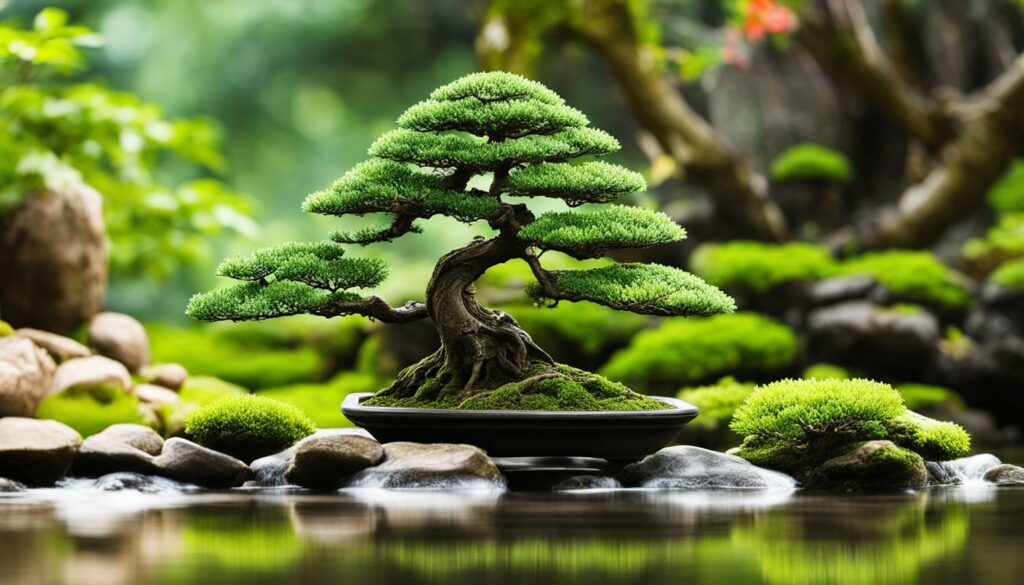
Below is a table listing common indoor air pollutants and the corresponding houseplants that can help mitigate their effects:
| Indoor Air Pollutant | Houseplant Solution | Effectiveness |
|---|---|---|
| Formaldehyde | Spider Plant (Chlorophytum comosum) | High |
| Carbon Monoxide | Peace Lily (Spathiphyllum) | Moderate |
| Benzene | English Ivy (Hedera helix) | High |
| Trichloroethylene | Gerbera Daisy (Gerbera jamesonii) | Moderate |
| Xylene and Toluene | Areca Palm (Dypsis lutescens) | Moderate to High |
By integrating some of these natural allies into your indoor garden, not only will you create a healthier environment for your bonsai, but you’ll also add to the beauty and diversity of your living space. Remember, maintaining optimal air quality is a continual practice that will yield tangible results in the form of a robust, thriving bonsai.
Assessing Your Bonsai’s Environment
Perfecting the environment for your bonsai is both an art and a science. To begin your bonsai environment evaluation, observation is key. Pay attention to how elements in your space impact your bonsai throughout various times of the day and different seasons. Assessing the ideal growing conditions isn’t a one-time task—it’s an ongoing process to ensure the vitality and beauty of your miniature tree.
Light is the lifeblood of all plants, and bonsai are no exception. Your bonsai should receive ample, but not excessive, sunlight to thrive. In particular, watch for signs of leaf scorching or inadequate growth, which could suggest that adjustments are necessary. Temperature is another critical variable; bonsai need a climate that mimics their natural habitat, whether it’s the cooler zones for a Juniper or the warmer climes for a Ficus.
Airflow is an often-overlooked aspect of bonsai care. Stagnant air can lead to fungal infections and pest infestations. Good circulation, on the other hand, can enhance leaf transpiration and photosynthesis, leading to healthier growth. Remember, assessing your bonsai’s environment is about finding balance. Too much wind can dehydrate your bonsai, while too little may stifle its potential.
As the context of each bonsai’s situation varies greatly, so does the path to creating its ideal environment. It’s a delicate dance between the factors of light, temperature, and airflow.
- Monitor light quality and duration—natural is preferable, but grow lights can supplement if necessary.
- Gauge indoor temperatures, aiming for a range suitable to your bonsai species.
- Ensure there’s gentle air movement around the bonsai to simulate a natural breeze.
- Consider the seasonality and how it affects these factors—adjustments may need to be seasonal.
Remember, the pursuit of crafting the ideal environment for your bonsai is a testament to your dedication as a bonsai artist. Trust your instincts, respond to your bonsai’s cues, and the harmonious environment you create will set the stage for a thriving, living masterpiece.
Bonsai Humidity and Air Circulation
Maintaining the health of your bonsai not only requires careful pruning and feeding but also ensuring the bonsai moisture levels are at their prime. An essential component of this process is the management of ventilation and adequate air circulation. These elements work in tandem to create a robust environment for your bonsai to thrive in.
Proper ventilation promotes an environment where humid air is refreshed and stale, potentially disease-ridden air is replaced with clean, oxygen-rich air. This encourages the bonsai to perform necessary gas exchange processes effectively, contributing to its overall vitality. So how do you ensure your indoor bonsai benefits from fresh airflow?
- Position your bonsai near a window, where it can benefit from natural air circulation, but not in the direct path of harsh winds.
- Integrate a fan into the room’s setup, utilizing it to simulate natural breezes that plants would encounter outdoors. Remember, gentle movement in the leaves is good, but avoid creating a mini-cyclone.
- Assess the room’s layout – Ensure your bonsai isn’t trapped behind obstructions like curtains or furniture, which can block air flow.
It’s not enough to just set up a fan and open a window; one must consider the balance between air movement and humidity. Here’s why:
- Too much air movement can dry out your bonsai, especially in arid climates—a potential threat to the delicate balance of moisture your bonsai requires.
- Conversely, insufficient air circulation could lead to stagnant, humid conditions that foster the growth of fungus and bacteria, potentially harmful to your bonsai.
In pursuit of this balance, consider the following table:
| Condition | Risks | Preventive Measures |
|---|---|---|
| Over Ventilation | Dryness, Dehydration | Use of humidity trays, regular misting |
| Inadequate Ventilation | Rot, Fungus | Strategic fan placement, periodic air quality checks |
| Ideal Circulation | N/A | Monitoring with hygrometers, routine environment adjustments |
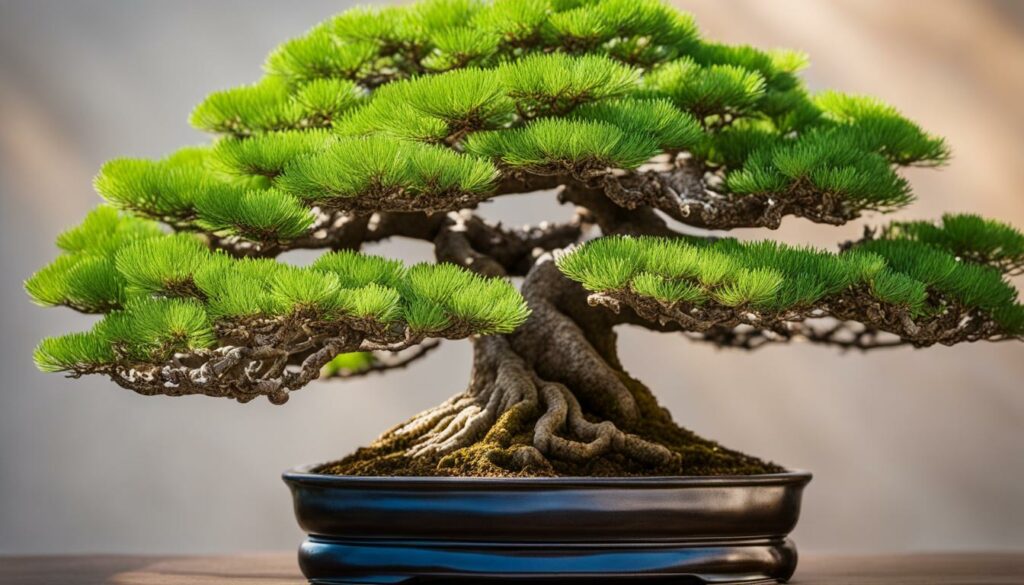
Achieving the right ventilation and humidity levels is a continuous dance that requires observation and adjustment. By understanding and managing these aspects correctly, you’ll create an environment for your bonsai that mirrors its natural habitat, fostering not only its survival but its prosperity as well.
Creating the Ideal Humidity Level for Different Bonsai Species
Successfully cultivating bonsai requires a nuanced understanding of each bonsai species requirements. In particular, the task of creating the ideal humidity level for your bonsai cannot use a one-size-fits-all approach. Therefore, tailored humidity care is paramount. Below, we’ve outlined general guidelines to align your care routine with the distinct needs of tropical, subtropical, and temperate bonsai species.
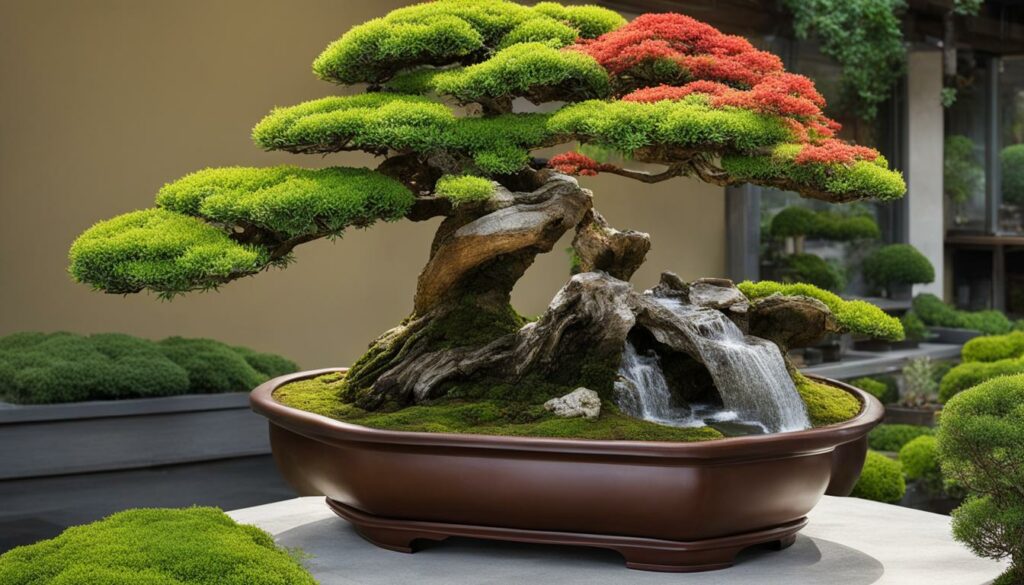
| Bonsai Species Category | Humidity Range | Daily Care Tips |
|---|---|---|
| Tropical Bonsai | 75% – 95% | Mist daily, provide a pebble tray with water |
| Subtropical Bonsai | 60% – 75% | Mist every other day, keep in well-ventilated area |
| Temperate Bonsai | 50% – 60% | Avoid over-misting, place outdoors when climate-appropriate |
It’s also worth noting that seasonal changes will affect your bonsai’s humidity needs. For instance, during the drier winter months, tropical and subtropical bonsai species may require additional humidity compared to the more humid summer months. Conversely, temperate species, which go dormant in the winter, generally require less humidity.
- Monitor your indoor humidity with a digital hygrometer to ensure you’re providing optimal conditions.
- Consider an indoor humidifier or dehumidifier to stabilize the environment around your bonsai.
- Be attentive to your bonsai’s response to humidity changes and adjust your care routine accordingly.
By understanding and catering to the differing bonsai species requirements, your efforts in maintaining tailored humidity care will result in the health and longevity of your cherished bonsai. Remember, observation and responsiveness to your bonsai’s unique needs will be your guide to mastering the art of bonsai humidity control.
Tools for Monitoring Humidity and Air Quality
Ensuring the health of your bonsai includes constant vigilance over the microenvironment it thrives in. Precise monitoring devices, responsive air purifiers, and effective humidity control systems are essential in creating the optimal conditions for your prized bonsai. Understanding and employing these tools can make all the difference in your bonsai care routine.
Humidity Gauges and Monitors
When it comes to nurturing a bonsai, awareness of humidity levels cannot be understated. A robust humidity gauge or monitor allows you to measure the moisture in the air with precision, alerting you to make adjustments when necessary. By keeping track of these levels, you can prevent the adverse effects of both dry and overly moist conditions that can stress or damage your bonsai.
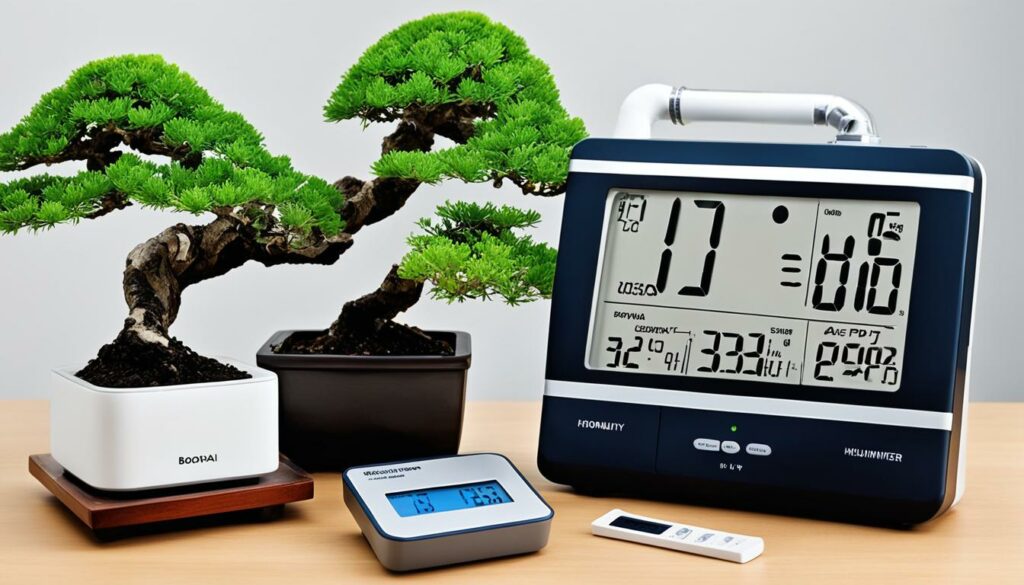
Air Purifiers and Fans
Clean air is just as important as the right humidity for your bonsai. Air purifiers can cleanse the air of potential pollutants and allergens, contributing to the overall well-being of the plant. Additionally, using fans to ensure adequate air circulation can help regulate humidity and prevent the stagnation of air, which can lead to fungal infections and other health problems in bonsai trees.
- Select the right size and type of air purifier for the room where your bonsai is kept.
- Place humidity monitors close to your bonsai for the most accurate readings.
- Use fans strategically to enhance air flow without exposing the bonsai to strong drafts.
Seasonal Changes and How They Affect Your Bonsai
As a bonsai enthusiast, it’s essential to understand that seasonal humidity variation plays a significant role in the well-being of your bonsai trees. Adapting your bonsai seasonal care routine to accommodate the shifting conditions brought on by seasonal changes is key to maintaining the health and beauty of your miniature landscapes. In this section, we’ll explore how to adjust care practices as the seasons evolve.
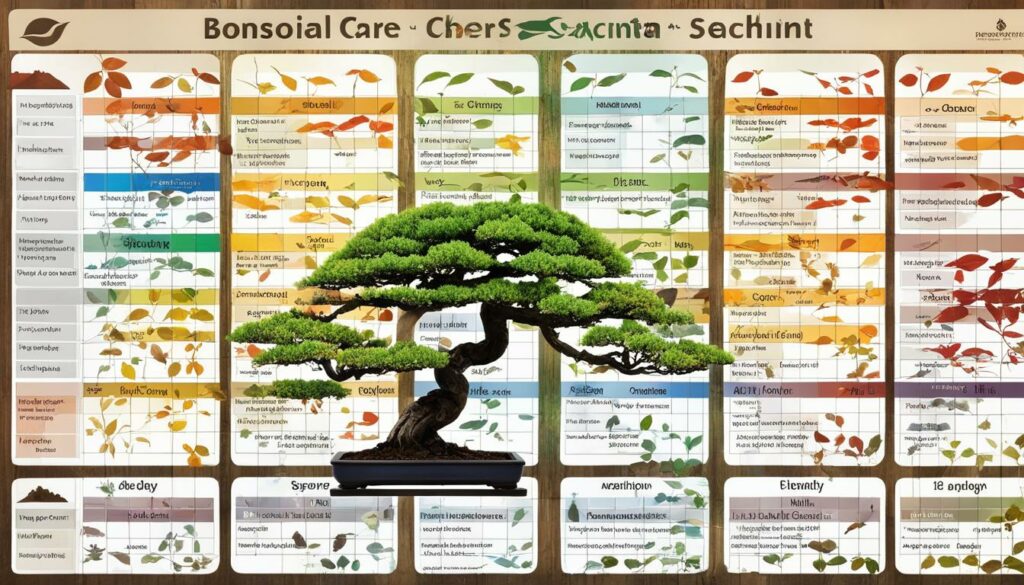
Spring often brings increased humidity, which can be beneficial for most bonsai species after a dry winter. However, as we move into the hot summer months, the combination of high temperatures and humidity can become a breeding ground for fungal diseases. During this time, ensuring good air circulation around your trees helps prevent these issues.
With the arrival of fall, the air becomes crisper, and humidity levels may drop off. This means you may need to compensate with more frequent watering or the use of a humidity tray. As winter sets in, cold and dry conditions might necessitate a move to a protected indoor environment, where humidity and temperature can be more closely controlled.
| Season | Typical Humidity Variation | Care Adjustments |
|---|---|---|
| Spring | Rising Humidity | Increase Monitoring, Gradual Watering Increase |
| Summer | High Humidity & Temperature | Enhance Air Circulation, Watch for Fungi |
| Fall | Decreasing Humidity | Consider Humidity Trays, Prep for Colder Weather |
| Winter | Low Humidity & Temperature | Move Indoors if Necessary, Use Humidifier |
To effectively navigate seasonal humidity variation, it’s also wise to utilize tools such as hygrometers to keep an eye on moisture levels. Your bonsai depend on you to mirror the natural ebb and flow of their native habitats through careful, seasonally-adjusted care.
Strategies for Controlling Humidity
Perfecting the art of humidity control can be a game-changer for your bonsai’s health and vitality. It’s not just about bringing a taste of its natural climate into your home; it’s about providing the foundation for your bonsai to flourish. Let’s delve into precision-driven strategies for maintaining that sweet spot of atmospheric moisture your bonsai craves.
Humidity Trays and Misting
Employing humidity trays is an eloquent solution for upping the ambient moisture. These trays, filled with water and pebbles, sit beneath your bonsai pots allowing for slow evaporation that adds to the local humidity. Misting with a fine spray bottle can also be refreshing for your bonsai; however, it’s important to strike a balance with misting – too much and you risk fungal diseases, too little and it’s ineffective. Here’s where a regular routine comes into play.
Room Humidifiers and Dehumidifiers
Integrating humidifiers for bonsai into your care regimen is a proactive approach to humidity management. While humidifiers increase moisture levels, dehumidifiers can be equally useful in overly damp conditions that harmfully sway the balance. Smart use of these devices not only safeguards the tree’s health but also contributes to a comfortable home environment.
- Choose a humidifier with a built-in humidistat for automatic regulation.
- Select dehumidifiers with care for spaces with excess moisture to protect the bonsai from root rot or mildew.
- Regular maintenance of these devices ensures their efficiency and longevity, contributing to a stable environment for your bonsai.
Adopting these humidity control strategies will pave the way for a thriving bonsai. No more guessing, just careful and considerate attention to the atmosphere’s ebb and flow around your living sculpture.
Proper Ventilation Practices for Bonsai Trees
In the delicate art of bonsai care, understanding and applying ventilation for bonsai is as essential as watering or fertilizing. Proper airflow around your bonsai tree is not just a matter of preference; it’s a critical component to avoid health issues such as fungal infections and root rot. The importance of airflow cannot be overstated—it maintains the balance of humidity and ensures a dynamic environment conducive to growth.
To create this balance, it’s important to facilitate a gentle yet steady stream of air around your bonsai. This doesn’t mean placing your tree in the path of a harsh fan or an open window where strong winds could desiccate the leaves. Instead, aim for a setup that mimics the natural breezes a tree would experience in an open forest or hillside. Here’s a guide to help you with that:
- Ensure your bonsai is not stuck in a stagnant corner; regular room airflow must reach it.
- If using a fan, opt for a small, low-powered one and position it so that there’s an indirect breeze.
- Circulate air in your room by occasionally opening windows, but avoid exposing your bonsai to cold drafts.
- During warmer months, an outdoor sheltered spot can provide natural airflow without the harshness of direct sun or strong winds.
Effectively managing your bonsai’s air exposure can be facilitated by understanding the typical airflow patterns in indoor environments. Here’s a comparative overview to illustrate:
| Location in Home | Airflow Characteristics | Considerations for Bonsai Placement |
|---|---|---|
| Near Windows | Variable depending on weather; risk of drafts | Monitor local weather to prevent exposure to extreme conditions |
| Interior Rooms | Mild, often stagnant air; limited circulation | Use fans or air purifiers to enhance circulation |
| Near Air Vents | Consistent controlled airflow; may be too intense | Ensure vents do not blow directly on bonsai; deflect airflow if needed |
| Sheltered Outdoor Area | Natural and gentle air movement; most ideal if weather permits | Protect from strong winds and excessive sun |
Recognizing the nuances of ventilation for bonsai and the importance of airflow, you can make informed decisions to navigate the challenges of indoor air management. By doing so, you’ll ensure your bonsai thrives and exhibits the serene beauty it’s revered for.
Common Problems Caused by Poor Air and Humidity Conditions
When nurturing bonsai trees, understanding the delicate balance of their environment is key. Bonsai diseases are often the result of poor air circulation consequences, which can lead to a host of issues. In the tranquility of their leaves and the stature of their trunks, bonsais communicate their distress. What might be imperceptible changes in the air and humidity could become critical setbacks for your bonsai’s health.
It is imperative to be vigilant for signs such as yellowing leaves, stunted growth, or a white, powdery mildew coating—the clarion calls of an unhappy bonsai. To further illustrate the concerns, consider the following table of common ailments caused by suboptimal conditions:
| Condition | Symptoms | Possible Cause |
|---|---|---|
| Root rot | Dark, mushy roots, wilting foliage | Excessive moisture, lack of proper drainage |
| Spider mites | Fine webs, yellow or bronze leaf discoloration | Poor air circulation, dry conditions |
| Fungal diseases | Leaf spots, defoliation | High humidity, inadequate airflow |
| Scale insects | Small, brown, bumpy lesions on branches | Stagnant air, dirty conditions |
Merely spotting these signs is not enough. Your bonsai requires prompt and effective action to mitigate the damage. Regular inspections, adequate ventilation, and humidity moderation are your best defense against such debilitating conditions. Ignoring these vital clues can quickly escalate into a battle against time and can endanger the life of your cherished bonsai.
Remember that the essence of bonsai lies as much in its splendor as in its health. The aesthetic beauty you strive for is deeply rooted in the well-being of the tree’s environment. Sometimes, the simplest changes to your bonsai’s air and humidity levels can make a world of difference. And when you listen to what your bonsai is telling you, both you and your tree can breathe a little easier.
Tips for Maintaining Consistent Humidity and Air Flow
Maintaining a stable environment is essential for the wellness of your bonsai, encompassing both consistent humidity and adequate air flow. Adhering to these tips will help you sustain the bonsai’s health and display its natural beauty.
- Monitor Humidity Daily: Invest in a reliable humidity monitor to keep track of moisture levels around your bonsai. Aim to maintain the humidity between 40-60% for most species.
- Water Wisely: Develop a regular watering schedule that maintains soil moisture without waterlogging the roots. This practice helps in preserving consistent humidity levels.
- Avoid Excessive Mist: While misting can increase humidity, overdoing it can lead to fungal issues. Light, occasional misting is beneficial, particularly during dry months.
- Use Humidity Trays: Placing your bonsai on a humidity tray filled with water and pebbles can help maintain a steady humid microclimate.
- Create A Steady Air Flow: Ensure that the room where your bonsai is located is not prone to stagnant air. Use fans to gently circulate air and open windows when possible, being cautious of drafts.
- Clean Leaves and Branches: Keeping your bonsai’s leaves dust-free promotes healthy air absorption and transpiration, thus supporting overall air flow and bonsai wellness.
- Position Strategically: Position your bonsai in an area where it can benefit from indirect sunlight and a consistent room temperature, as wide fluctuations can affect humidity and air flow.
By closely following these guidelines, you can foster an optimal environment that simulates a bonsai’s natural habitat, ensuring your bonsai remains healthy and vibrant for years to come.
Balancing Humidity and Air Quality with Bonsai Aesthetics
Creating a harmonious environment design for your bonsai includes more than just keeping the plant alive; it’s about integrating essential humidity and air quality controls into the aesthetic bonsai presentation. This can be challenging, but with a bit of creativity, these functional elements can add to the beauty of your display rather than detract from it.
- Strategically place humidity trays beneath your bonsai containers. Opt for trays that complement the style and color of your bonsai pots. Materials such as bamboo or slate can enhance the natural appearance while serving their functional purpose.
- Choose air purifiers that have a visually appealing design. Nowadays, you can find models that are sleek and stylish, which can blend into the background or even serve as a conversation piece.
- Consider enclosing your bonsai within glass terrariums, which allows for excellent control over the humidity and air quality while also providing a unique visual aspect to your display. Just make sure there’s adequate ventilation to prevent mold growth.
- Integrate natural elements such as pebbles, moss, or wood pieces around the base of your bonsai. This not only adds to the moisture retention and air purity but also increases the visual appeal of your setup.
One effective method to seamlessly integrate these elements is to incorporate a multifunctional piece of furniture designed with bonsai aesthetics in mind. Below is a comparative table showcasing some versatile items:
| Item | Functionality | Design Aesthetics |
|---|---|---|
| Bamboo Humidity Tray | Provides necessary moisture | Natural look that complements bonsai |
| Designer Air Purifier | Cleans the air efficiently | Minimalistic and modern to suit contemporary spaces |
| Glass Terrarium | Allows for optimal atmospheric control | Acts as a statement piece that showcases your bonsai |
| Decorative Stones and Moss | Assists with humidity and adds texture | Enhances the visual ‘zen’ experience |
With these strategies and decorative items, you can ensure that your bonsai thrives in a delightful display that complements the rest of your living space.
Case Studies: Success Stories in Bonsai Humidity and Ventilation Management
Exploring bonsai case studies, we uncover narratives from avid growers who have excelled in crafting the perfect atmosphere for their bonsai collections. Through successful humidity management, these individuals have navigated the complexities of creating a conducive environment for their prized trees.
For example, a bonsai enthusiast from the humid climate of Florida utilized a combination of humidity trays and strategically placed fans to ward off mold growth and maintain the delicate balance needed for his juniper bonsai. Meanwhile, a grower in arid Arizona installed a high-quality humidifier and used daily misting techniques to preserve the necessary moisture levels for her tropical bonsai collection.
These case studies illustrate the dedication and adaptability required to tailor an environment suited for bonsai cultivation. With the right tools and techniques, bonsai enthusiasts can mitigate the challenges posed by their unique climates.
Let’s examine these detailed examples further with a table highlighting the methods and outcomes for these bonsai aficionados:
| Grower Location | Bonsai Type | Challenges | Humidity Management Techniques | Outcome |
|---|---|---|---|---|
| Florida | Juniper | High ambient humidity, mold risk | Humidity trays, circulating fans | Healthy growth, mold-free |
| Arizona | Tropical varieties | Low ambient humidity, dehydration risk | Room humidifier, daily misting | Lush foliage, optimal moisture levels |
These success stories serve as a testament to the importance of observing, experimenting, and responding to the unique needs of bonsai. By tapping into the collective wisdom of experienced growers, you too can cultivate a thriving bonsai that not only survives but flourishes in its environment.
Conclusion
As we’ve navigated through the intricacies of maintaining the ideal humidity and air circulation, it has become evident that these elements are not merely beneficial, but essential to the prosperity of your bonsai. This bonsai care summary has provided a comprehensive outlook on how to cultivate an optimal environment tailored to your bonsai’s unique needs. Whether it’s the tropical vibrancy or the subtle grace of a temperate specimen, understanding and customizing the humidity and air quality is paramount.
Remember, the journey to a flourishing bonsai is punctuated with careful observation and adaptation. Employ the final humidity and air quality tips to calibrate the atmosphere, harnessing tools such as humidity gauges, air purifiers, and strategically placed fans. Utilize humidity trays and misting techniques to gently nurture your bonsai, always considering the delicate balance required for ventilation and moisture.
Your dedication to applying these principles will no doubt culminate in the reward of a robust and verdant bonsai. As you implement advanced strategies and refine the environmental factors, consider each adjustment an investment in the visual poetry that is bonsai. Embark on this cultivation quest with a keen eye and a nurturing hand, and watch as your bonsai flourishes, an embodiment of natural beauty in miniature form.
FAQ
How do I know if the humidity level is correct for my bonsai?
The ideal humidity level for your bonsai depends on its species. Generally, maintaining a humidity level between 40% to 60% is good for most bonsai trees. Use a humidity gauge or monitor to measure and maintain the correct levels.
Can the air quality in my home affect the health of my bonsai?
Yes, poor air quality due to indoor pollutants can adversely affect your bonsai. It’s important to ensure that the air around your bonsai is clean to avoid issues with growth and health.
What kind of ventilation do bonsai trees need?
Bonsai trees require adequate air circulation to prevent diseases. Ensure they are placed in an area with a gentle airflow. Avoid strong winds or drafts, as these can dry out the bonsai too quickly.
How often should I adjust the humidity for my bonsai?
Humidity levels should be monitored regularly and adjusted according to seasonal changes. Keep in mind that different species may have varying humidity needs.
Are there any tools I can use to control the humidity and air quality for my bonsai?
Yes, there are several tools available, such as humidity trays, misters, room humidifiers, dehumidifiers, air purifiers, and fans to help control the environment around your bonsai.
What are common problems caused by poor humidity and air conditions for bonsai trees?
Common problems include leaf wilting, yellowing, pests, root rot, and fungal diseases. Pay attention to your bonsai’s condition and adjust the air and humidity accordingly.
Is there a way to balance bonsai care with maintaining an aesthetically pleasing display?
Absolutely. You can integrate functional elements like humidity trays and air purifiers into the display area in ways that complement the aesthetic of your bonsai collection.
Can I use a fan to provide air circulation for my bonsai?
Yes, fans can help to provide air circulation, but it’s important to ensure that the fan doesn’t blow directly on the bonsai as this can cause the soil to dry out too rapidly. Position the fan to circulate the air around the room instead.
Do I need to adjust my bonsai’s environment between seasons?
Seasonal adjustments are important for bonsai care. For instance, during winter, indoor heating can reduce humidity levels, necessitating the use of humidifiers or other methods to keep your bonsai hydrated.
How often should I change the location of my bonsai to ensure good air quality and circulation?
The location of your bonsai should be relatively stable. Avoid frequent moves that can stress the plant. However, you may need to adjust the location seasonally or if you notice signs of poor air quality or inadequate air circulation.
